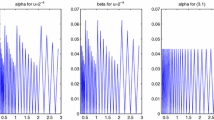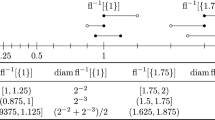Abstract
The paper shows that floating-point matrix operations can be implemented in a way which leads to reasonable mathematical structures as well as to sensible compatibility properties between these structures and the structure of the real matrices. It turns out, for instance, that all the rules of the minus-operator for real matrices can be saved and that for all elements which are comparable with 0 with respect to ≦ and ≧ the same rules for inequalities hold as for real matrices. These structures also occur in other fields of mathematics [5], [6], [7]. They allow many theoretical considerations with floating-point matrices. The proposed implementation, furthermore, leads to a higher accuracy of floating-point matrix operations and allows a much simpler error analysis (Theorem 2.5).
Theorem 2.3 is the main result for the implementation. It reduces the structure of floating-point matrices to special properties of the rounding function and to a special definition of the operations. In chapter 1 these properties are derived as necessary conditions for an algebraic and order homomorphism between the real matrices and the floating-point matrices.
The last chapter gives the algorithms for the implementation of floating-point matrix operations for all roundings of the set {▽, △,\(\square _\mu \), μ=0(1)b} (for definition see chapter 1) using a special accumulator (Fig. 3 in chapter 3). It is an essential result that the implementation of all operations can be separated into several independent steps which means that an exchange of the rounding does not influence any other part of the algorithm.
Zusammenfassung
Die Arbeit zeigt, daß Gleitkommamatrixverknüpfungen in einer Weise implementiert werden können, welche eine vernünftige mathematische Struktur wie auch sinnvolle Verträglichkeitsbedingungen zwischen der Struktur der reellen Matrizen und derjenigen der Gleitkommamatrizen erlaubt. Es stellt sich beispielsweise heraus, daß alle Regeln für den Minusoperator bei reellen Matrizen erhalten werden können und daß für alle mit Null vergleichbaren Elemente bezüglich ≦ und ≧ dieselben Regeln für das Rechnen mit Ungleichungen gelten wie für reelle Matrizen. Die sich ergebenden Strukturen treten auch in anderen Gebieten der Mathematik auf [5], [6], [7]. Sie ermöglichen viele theoretische Untersuchungen mit Gleitkommamatrizen. Die vorgeschlagene Implementierung hat ferner eine höhere Genauigkeit der Verknüpfungen für Gleitkommamatrizen zur Folge und erlaubt eine wesentlich einfachere Fehleranalysis (Satz 2.5).
Der Satz 2.3 stellt das Hauptergebnis für die Implementierung dar. Er führt die Struktur der Gleitkommamatrizen zurück auf spezielle Eigenschaften der Rundungsfunktion und eine spezielle Definition der Verknüpfungen. Im ersten Abschnitt werden diese Eigenschaften als notwendige Bedingungen für einen algebraischen und Ordnungshomomorphismus zwischen den reellen Matrizen und den Gleitkommamatrizen hergeleitet.
Der letzte Abschnitt behandelt die Algorithmen für die Implementierung der Verknüpfungen für Gleitkommamatrizen für alle Rundungsfunktionen der Menge {▽, △,\(\square _\mu \), μ=0(1)b} (bezüglich der Definition siehe den ersten Abschnitt). Dabei wird ein spezieller Akkumulator verwendet (Abb. 3 im dritten Abschnitt). Ein wesentliches Ergebnis besteht darin, daß die Implementierung für alle Operationen in verschiedene, voneinander unabhängige Schritte zerlegt werden kann. Dies bedeutet beispielsweise, daß ein Austausch der Rundungsfunktion keinen anderen Teil des Gesamtalgorithmus beeinflußt.
Similar content being viewed by others
References
Christ, H.: Realisierung einer Maschinenintervallarithmetik auf beliebigen ALGOL-60-Compilern. Elektronische Rechenanlagen10, H. 5, 217–222 (1968).
Herzberger, J.: Metrische Eigenschaften von Mengensystemen und einige Anwendungen, Dr.-Dissertation, Universität Karlsruhe, 1969, p. 1–49.
Knut, D.: The Art of Computer Programming. Addison-Wesley, 1969, Vol. 2.
Kulisch, U.: An Axiomatic Approach to Rounded Computations, Mathematics Research Center, The University of Wisconsin, Madison, Wisconsin. Technical Summary Report Nr. 1020, Nov. 1969, p. 1–29, and Num. Math. 18, p. 1–17 (1971).
Kulisch, U.: Rounding Invariant Structures. Mathematics Research Center, The University of Wisconsin, Madison, Wisconsin. Technical Summary Report Nr. 1103, Sept. 1970, p. 1–47.
Kulisch, U.: Grundlagen des Numerischen Rechnens. Niederschrift einer vierstündigen Vorlesung, gehalten im WS 1970/71 an der Universität Karlsruhe, S. 1–250.
Kulisch, U.: Implementation and Formalization of Floating-Point Arithmetics, IBM T.J. Watson-Research Center, Report Nr. RC 4608, Nov. 1973, p. 1–50, published in part in Computing under the title: Formalization and Implementation of Floating-Point Arithmetics.
Kulisch, U.: Über die Arithmetik von Rechenanlagen, Universität Karlsruhe, Aug. 1974, S. 1–74, to appear in “Überblicke Mathematik 1975”. Mannheim-Wien-Zürich: Bibliographisches Institut.
Ullrich, Ch.: Rundungsinvariante Strukturen mit äußeren Verknüpfungen. Dr.-Dissertation, Universität Karlsruhe, 1972, p. 1–67.
Wilkinson, J. H.: Rundungsfehler. Berlin-Heidelberg-New York: Springer 1969.
Yohé, J. M.: Roundings in Floating-Point Arithmetic. IEEE Transactions on Computers, Vol. C-22, No. 6, June 1973.
Author information
Authors and Affiliations
Additional information
Dedicated to J. Weissinger on the occasion of his 62-nd birthday.
Rights and permissions
About this article
Cite this article
Kulisch, U., Bohlender, G. Formalization and implementation of floating-point matrix operations. Computing 16, 239–261 (1976). https://doi.org/10.1007/BF02280883
Received:
Issue Date:
DOI: https://doi.org/10.1007/BF02280883




